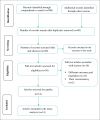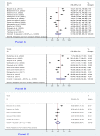A systematic review and meta-analysis of antimicrobial resistance knowledge, attitudes, and practices: Current evidence to build a strong national antimicrobial drug resistance narrative in Ethiopia
- PMID: 37294747
- PMCID: PMC10256206
- DOI: 10.1371/journal.pone.0287042
A systematic review and meta-analysis of antimicrobial resistance knowledge, attitudes, and practices: Current evidence to build a strong national antimicrobial drug resistance narrative in Ethiopia
Abstract
Antimicrobial resistance (AMR) is a silent pandemic that has claimed millions of lives, and resulted in long-term disabilities, limited treatment options, and high economic costs associated with the healthcare burden. Given the rising prevalence of AMR, which is expected to pose a challenge to current empirical antibiotic treatment strategies, we sought to summarize the available data on knowledge, attitudes, and practices regarding AMR in Ethiopia. Articles were searched in international electronic databases. Microsoft Excel spreadsheet and STATA software version 16 were used for data extraction and analysis, respectively. The Preferred Reporting Items for Systematic Reviews and Meta-Analysis 2020 checklist was followed. The methodological quality of the studies included was assessed by the Joana Briggs Institute critical appraisal checklists. The random-effect meta-analysis model was used to estimate Der Simonian-Laird's pooled effect. Statistical heterogeneity of the meta-analysis was checked through Higgins and Thompson's I2 statistics and Cochran's Q test. Publication bias was investigated by funnel plots, and the regression-based test of Egger for small study effects with a P value < 0.05 was considered to indicate potential reporting bias. In addition, sensitivity and subgroup meta-analyses were performed. Fourteen studies with a total of 4476 participants met the inclusion criteria. Overall, the pooled prevalence of good AMR knowledge was 51.53% [(95% confidence interval (CI): 37.85, 65.21), I2 = 99.0%, P <0.001]. The pooled prevalence of favorable attitudes and good practices were 63.43% [(95% CI: 42.66, 84.20), I2 = 99.6, P <0.001], and 48.85% [(95% CI: 38.68, 59.01), I2 = 93.1, P <0.001] respectively. In conclusion, there is a significant knowledge and practice gap on AMR among the general public, patients, and livestock producers. As a result, we call for greater educational interventions to raise awareness and build a strong national AMR narrative.
Copyright: © 2023 Woldegeorgis et al. This is an open access article distributed under the terms of the Creative Commons Attribution License, which permits unrestricted use, distribution, and reproduction in any medium, provided the original author and source are credited.
Conflict of interest statement
The authors have declared that no competing interests exist
Figures



Similar articles
-
Ethiopians' knowledge of and attitudes toward epilepsy: A systematic review and meta-analysis.Front Neurol. 2023 Feb 28;14:1086622. doi: 10.3389/fneur.2023.1086622. eCollection 2023. Front Neurol. 2023. PMID: 36925943 Free PMC article. Review.
-
Global knowledge, attitudes, and practices towards antimicrobial resistance among healthcare workers: a systematic review and meta-analysis.Antimicrob Resist Infect Control. 2025 May 13;14(1):47. doi: 10.1186/s13756-025-01562-1. Antimicrob Resist Infect Control. 2025. PMID: 40361230 Free PMC article.
-
Antimicrobial resistance profile of Pseudomonas aeruginosa clinical isolates from healthcare-associated infections in Ethiopia: A systematic review and meta-analysis.PLoS One. 2024 Aug 13;19(8):e0308946. doi: 10.1371/journal.pone.0308946. eCollection 2024. PLoS One. 2024. PMID: 39137234 Free PMC article.
-
Knowledge, attitude and practice of healthcare workers on infection prevention and control in Ethiopia: A systematic review and meta-analysis.PLoS One. 2024 Sep 5;19(9):e0308348. doi: 10.1371/journal.pone.0308348. eCollection 2024. PLoS One. 2024. PMID: 39236020 Free PMC article.
-
Prevalence of knowledge, attitudes, and practices regarding antimicrobial resistance in Africa: a systematic review and meta-analysis.Front Microbiol. 2024 Mar 22;15:1345145. doi: 10.3389/fmicb.2024.1345145. eCollection 2024. Front Microbiol. 2024. PMID: 38585703 Free PMC article.
Cited by
-
Knowledge, Attitudes, and Practices of Rural Communities Regarding Antimicrobial Resistance and Climate Change in Adadle District, Somali Region, Ethiopia: A Mixed-Methods Study.Antibiotics (Basel). 2024 Mar 22;13(4):292. doi: 10.3390/antibiotics13040292. Antibiotics (Basel). 2024. PMID: 38666968 Free PMC article.
-
Risk Factors Associated with Opportunistic Infections among People Living with HIV/AIDS and Receiving an Antiretroviral Therapy in Gabon, Central Africa.Viruses. 2024 Jan 4;16(1):85. doi: 10.3390/v16010085. Viruses. 2024. PMID: 38257785 Free PMC article.
-
Social and ecological determinants of antimicrobial resistance in Africa: a systematic review of epidemiological evidence.Antimicrob Steward Healthc Epidemiol. 2024 Sep 9;4(1):e119. doi: 10.1017/ash.2024.375. eCollection 2024. Antimicrob Steward Healthc Epidemiol. 2024. PMID: 39257424 Free PMC article. Review.
-
Health professional and facility engagement in antimicrobial resistance prevention and containment strategic initiatives at public hospitals in Southern Ethiopia: facility-based cross-sectional study.BMJ Public Health. 2025 Apr 17;3(1):e002314. doi: 10.1136/bmjph-2024-002314. eCollection 2025. BMJ Public Health. 2025. PMID: 40260122 Free PMC article.
-
Enhancing community awareness of antimicrobial use and resistance through community conversations in rural Ethiopia.One Health Outlook. 2025 May 6;7(1):28. doi: 10.1186/s42522-025-00148-6. One Health Outlook. 2025. PMID: 40329422 Free PMC article.
References
-
- FAO (2016) Action Plan on Antimicrobial Resistance 2016–2020; supporting the food and agriculture sectors in implementing the Global Action Plan on Antimicrobial Resistance to minimize, the impact of antimicrobial resistance. Rome,Italy
-
- Organization WH (2019) Turning plans into action for antimicrobial resistance (AMR): working paper 2.0: implementation and coordination. World Health Organization.
Publication types
MeSH terms
Substances
LinkOut - more resources
Full Text Sources
Medical
Research Materials
Miscellaneous

